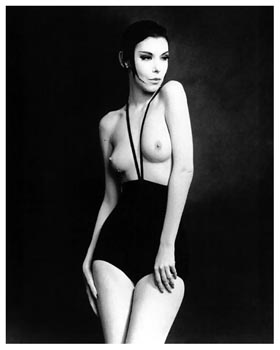Monokini
Monokini
The monokini is a type of swimsuit that is characterized by its unique design, which typically exposes more skin than a traditional one-piece swimsuit. The monokini is often considered a daring and bold fashion choice, and it has evolved significantly since its inception.
History[edit | edit source]
The monokini was first introduced in the 1960s by Austrian-American fashion designer Rudi Gernreich. Gernreich's original design was a topless swimsuit that featured only the bottom half of a traditional bikini, held up by thin straps. This design was revolutionary and controversial at the time, as it challenged the conservative swimwear norms of the era.
Design[edit | edit source]
Modern monokinis come in a variety of styles and designs. While the original monokini was topless, contemporary versions often feature a one-piece design with cutouts that expose the midriff, sides, or back. These cutouts can vary in size and shape, offering different levels of coverage and support. Some monokinis also include decorative elements such as rhinestones, sequins, or lace.
Cultural Impact[edit | edit source]
The monokini has had a significant impact on fashion and swimwear trends. It has been featured in numerous fashion magazines and has been worn by celebrities and fashion icons. The monokini's bold design has also sparked discussions about body image, modesty, and the evolving standards of beauty.
Variations[edit | edit source]
There are several variations of the monokini, including:
- Strapless Monokini: A design that does not include shoulder straps, relying on the structure of the swimsuit to stay in place.
- Halter Monokini: Features a halter neck strap that provides additional support and coverage.
- Plunge Monokini: Characterized by a deep V-neckline that plunges down the front of the swimsuit.
- High-Waisted Monokini: Combines elements of a high-waisted bikini with the cutout design of a monokini.
See Also[edit | edit source]
References[edit | edit source]
External Links[edit | edit source]
Search WikiMD
Ad.Tired of being Overweight? Try W8MD's physician weight loss program.
Semaglutide (Ozempic / Wegovy and Tirzepatide (Mounjaro / Zepbound) available.
Advertise on WikiMD
|
WikiMD's Wellness Encyclopedia |
| Let Food Be Thy Medicine Medicine Thy Food - Hippocrates |
Translate this page: - East Asian
中文,
日本,
한국어,
South Asian
हिन्दी,
தமிழ்,
తెలుగు,
Urdu,
ಕನ್ನಡ,
Southeast Asian
Indonesian,
Vietnamese,
Thai,
မြန်မာဘာသာ,
বাংলা
European
español,
Deutsch,
français,
Greek,
português do Brasil,
polski,
română,
русский,
Nederlands,
norsk,
svenska,
suomi,
Italian
Middle Eastern & African
عربى,
Turkish,
Persian,
Hebrew,
Afrikaans,
isiZulu,
Kiswahili,
Other
Bulgarian,
Hungarian,
Czech,
Swedish,
മലയാളം,
मराठी,
ਪੰਜਾਬੀ,
ગુજરાતી,
Portuguese,
Ukrainian
Medical Disclaimer: WikiMD is not a substitute for professional medical advice. The information on WikiMD is provided as an information resource only, may be incorrect, outdated or misleading, and is not to be used or relied on for any diagnostic or treatment purposes. Please consult your health care provider before making any healthcare decisions or for guidance about a specific medical condition. WikiMD expressly disclaims responsibility, and shall have no liability, for any damages, loss, injury, or liability whatsoever suffered as a result of your reliance on the information contained in this site. By visiting this site you agree to the foregoing terms and conditions, which may from time to time be changed or supplemented by WikiMD. If you do not agree to the foregoing terms and conditions, you should not enter or use this site. See full disclaimer.
Credits:Most images are courtesy of Wikimedia commons, and templates, categories Wikipedia, licensed under CC BY SA or similar.
Contributors: Prab R. Tumpati, MD



